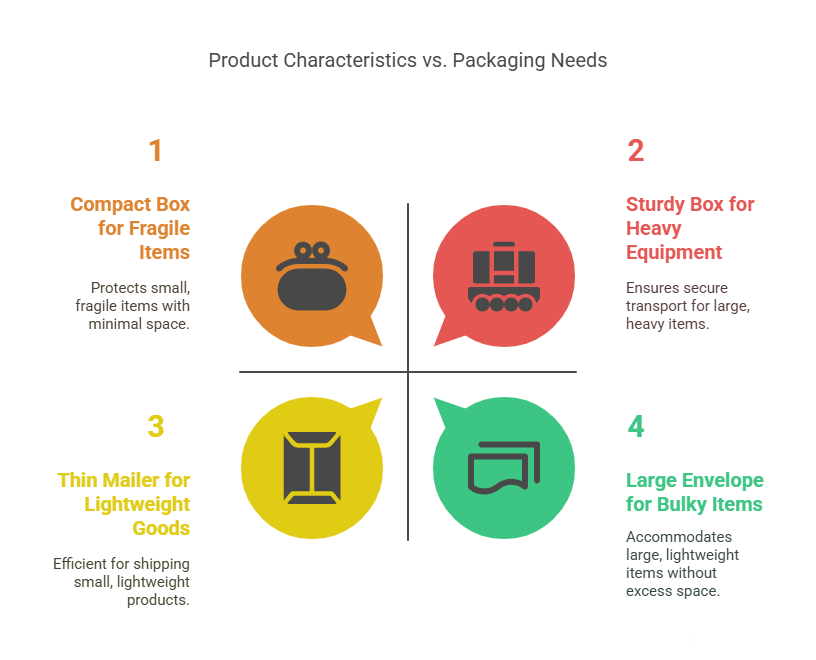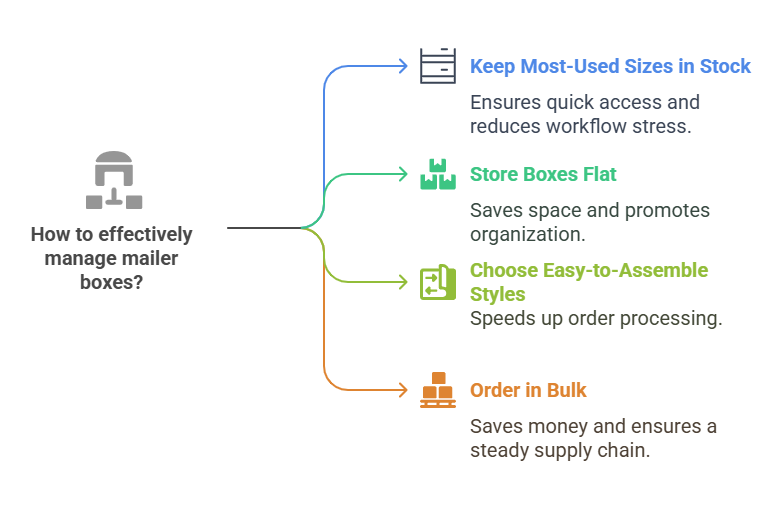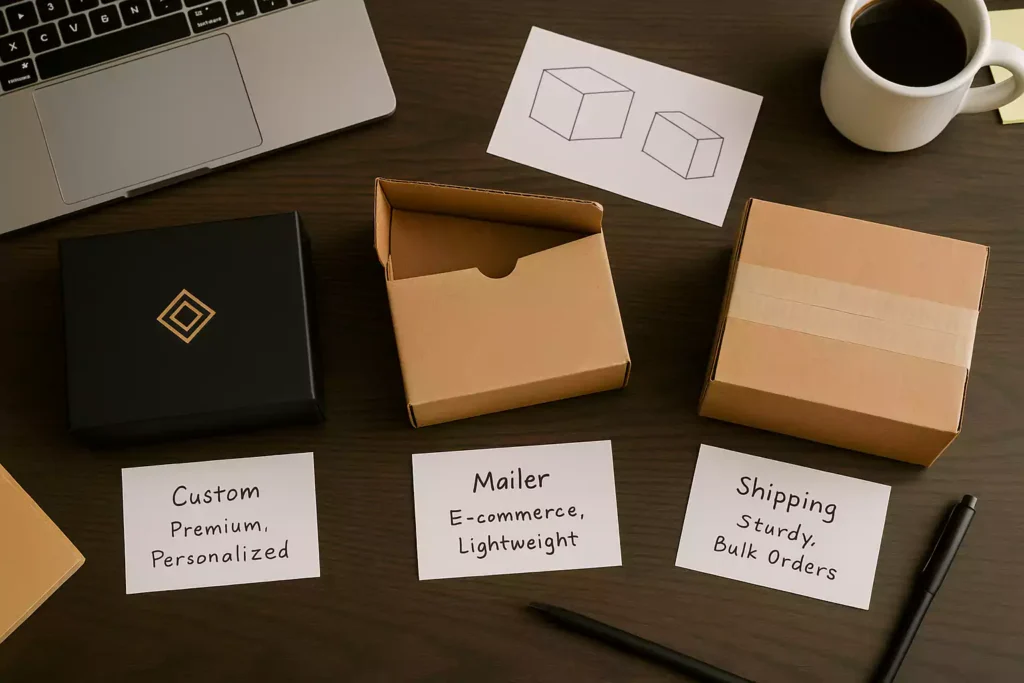Box size doesn’t seem like a big deal until you’re staring at a shelf full of wasted space or returns from crushed products. Getting the right fit makes your life easier. It helps with packing, keeps your product protected, and cuts down your shipping costs more than most people expect.
If you use a box that’s too big, you’ll waste filler, burn through tape, and spend more than you need. And if you go too small, your product will get jammed in or show up damaged. Both will hurt your customers’ experience and slow things down behind the scenes.
That’s why more businesses are paying attention to box size. With more brands shifting toward environmentally friendly and cost effective packaging, getting the size right helps you work smarter, reduce waste, and keep your process more efficient.
Read on to see how to choose a mailer box size that fits your product, your budget, and the way you ship. No guessing, no overthinking, just straightforward advice to help you get it right the first time.
Understand Your Product’s Needs
Before you start shopping for boxes, get clear on what you’re packing. The best way to find a suitable mailer is to begin with the basics.
First, measure your product. Take note of the length, width, and height, and focus on the internal dimensions of the box, not just the outer measurements. This helps you avoid surprises when it’s time to pack.

Weight also matters. A lightweight item might be fine in a thin mailer, but fragile items or heavier products need something sturdier with a tighter fit. If your product shifts around in transit, it’s more likely to arrive scratched, cracked, or worse.
Don’t forget about shape. Products like flyers, jewellery, or anything oddly shaped like a round tin or sculpted bottle may not sit well in a generic rectangle. If the item’s too small for the box, it can get lost or damaged. If it’s too bulky, it won’t sit flat or secure, even with filler.
Small items and smaller goods often need more care than bulkier products. The right box keeps them snug without crowding them in. A box that fits well gives you a cleaner finish, better protection, and a much smoother process when you’re packing to scale.
How Mailer Box Size Affects Shipping Costs
Box size directly affects how much you pay to ship a product. Carriers calculate shipping costs based on both weight and dimensions, so even a lightweight item can get expensive if the box is oversized. You’re not only paying for what you send but also for the space it takes up in transport.
With Royal Mail, for example, packages are grouped into size-based categories like Large Letter, Small Parcel, and Royal Mail Small Parcels. The difference between those categories might only be a few centimeters, but it can impact what you pay at despatch, how you apply your label, and how much cash you spend on every shipment.
Here’s a quick example:
Send a pair of earrings in a compact box that qualifies as a Large Letter, and you’ll pay less and skip the filler. Use a bigger box and it bumps into Small Parcel territory, which costs more, wastes materials, and takes up more room in transit.
Right-sizing also means less tape, less filler, and fewer packing materials overall. That keeps your workflow lean and your shipping more cost effective, especially when you’re sending a high volume of orders.
Pro Tip: We recommend checking carrier size brackets before ordering your packaging. Even shaving off a centimeter can move your box into a cheaper shipping category, especially with services like Royal Mail Small Parcels or Large Letters. That small change adds up fast when you're shipping at scale.
Choosing the Appropriate Box Style
Different products need different types of boxes. The key is to match the style to your product’s shape, fragility, and how you plan to pack and ship it. Here’s a quick look at the most common options:
| Box Style | Best For | Why It Works |
| Postal Box | General products, subscriptions | Durable, folds flat, and fast to assemble |
| Rigid Envelope | Flyers, brochures, flat items | Slim and stiff, great for clean door delivery |
| Gift Box | Jewellery, premium items | Strong and elegant, it adds protection and style |
| Subscription Box | Multi-item kits, small batches | Built for volume and secure closure |
Now, how do you choose the right one? Here’s what we recommend:
- Go with postal boxes if you want something sturdy and dependable. These are the all-rounders. They are easy to store, fast to pack, and tough enough for most shipping setups.
- Use envelopes for documents or printed materials. They keep things flat and professional without the bulk.
- Gift boxes work well for items that need to look polished, like jewellery or curated sets. They also give extra structure where presentation matters.
- Subscription-style mailers are great when you’re shipping multiple products together. They save time in fulfillment and keep things secure without overcomplicating the process.
Avoiding Common Mistakes When Choosing Box Size
Choosing the wrong box size creates more problems than most people expect. These are the common pitfalls we see most often:
- Too much space around your product means you’ll need more filler and more tape to secure everything. It also raises your shipping cost and increases the chance of things shifting in transit.
- A box that’s too tight can bend or crush your item, especially if it’s fragile or oddly shaped. It also makes the unboxing feel rushed or messy, which doesn’t help your presentation.
- Forgetting the extras like branded inserts, return cards, or add-ons can throw off your whole layout. It’s easy to forget how much those small items affect what your packaging needs to accommodate.
- No breathing room leaves you with less flexibility. If you ever need to swap in a slightly different version of a product, a too-specific box can slow things down or cause repacking headaches.
Give your product enough space to stay secure and cleanly packed, but not so much that you’re paying to ship empty air. The right fit keeps things fast, neat, and easy to scale.
How to Choose Mailer Box Size Based on Product Category
Every product has its own packaging needs. Instead of trying to force everything into one box, choose from a range of suitable options based on size, shape, and how much protection your item needs in transit.
Here’s a quick breakdown of common product types and what tends to work best:
| Product Type | Recommended Size Range | Notes |
| Flyers & brochures | Fits in Large Letter Box | Go flat with minimal filler. Keep it neat and slim. |
| Jewellery & small goods | Extra small postal box | Stay snug and secure. Avoid too much empty space. |
| Apparel | Small or medium parcel box | Go fold-flat. Easy to pack and stack. |
| Cosmetics & jars | Medium-sized box | Use bubble wrap or dividers to prevent shifting. |
| Gift sets | Custom or rigid box | Prioritize presentation and solid protection. |
This is just a starting point. Various sizes within each category can help you fine-tune your packaging to match your exact product. When in doubt, consider how fragile the item is, how it’s shaped, and what kind of experience you want the customer to have when they open it. A box that’s just the right fit will protect your item, saves space, and make your brand feel more thoughtful without adding complexity to your process.
Materials Matter: Strength and Sustainability
The material you choose affects how well your box performs, how your product arrives, and how your brand is perceived. Not every product needs heavy-duty packaging, but every product does need the right match.
If your item is heavy or fragile, corrugated board is the safer pick. It holds its shape during shipping, adds impact resistance, and helps protect your product from dents or crushing. For lighter items like accessories or small kits, a lightweight paperboard box can work just as well while saving space and cost.
More brands are shifting toward plastic free packaging and using environmentally friendly materials like recycled kraft, FSC-certified paper, or compostable liners. These give your package a natural look while reducing your footprint.
You’ll also want to think about what you keep in stock. Stick with a few core options that work across multiple products, and use customization when the product calls for it—like custom sizing, branding, or upgraded textures. It’s a balance between everyday efficiency and moments when the experience matters more.
Pro Tip: We recommend choosing based on quality and how well the box performs from packing to delivery. Every package that reaches your customer reflects your brand, so it’s worth getting it right.
Tips for Storing and Ordering Mailer Boxes
A good box setup doesn’t stop at choosing the right size. How you store, restock, and organize your packaging matters just as much, especially when you’re shipping regularly.
1. Keep your most-used sizes in stock
If you rely on a few key box sizes, keep them ready to go. Running out slows everything down and adds stress to your packing workflow.
2. Store boxes flat to save space
Flat-packed mailers take up less space on shelves and help you stay organized. Just fold what you need when it’s time to despatch.

3. Choose styles that assemble easily
Box style makes a difference. The easier it is to fold and close, the faster you move through orders, especially during busy weeks.
4. Order in bulk when you can
Buying in larger quantities helps you save money per unit and avoid delays during restocks. It also keeps your supply chain steadier, which is helpful for growing businesses.
Where to Start: Measuring Tools & Resources
Not sure how to measure your product or pick the right box? Start with the basics and get it right the first time.
- Use a printable ruler or online sizing calculator like this one from OnlineLabels
- Always measure your actual product—not the packaging it came in or a rough guess
- Focus on internal dimensions, especially when you’re working with snug fits or grouped items
- Leave a small margin inside the box to allow for padding or movement without compromising protection
The benefit of starting with exact measurements is fewer surprises during fulfillment and less back-and-forth when ordering packaging on your website
On A Final Note:
Getting the right size box helps you ship smarter, reduce waste, and protect your product every step of the way. It also keeps your packing process clean and efficient, which makes a real difference as your business grows.
If you’re ready to choose a mailer box size that works for your product and your workflow, we’re here to help. You can browse sizes, test samples, or start a custom design that fits your brand and your day-to-day.
Visit our website to see what’s available, or reach out if you need help finding the right fit. You might be shipping a single product or handling a steady flow of mail orders. Either way, there’s real benefit in packaging that’s built around how you work.




